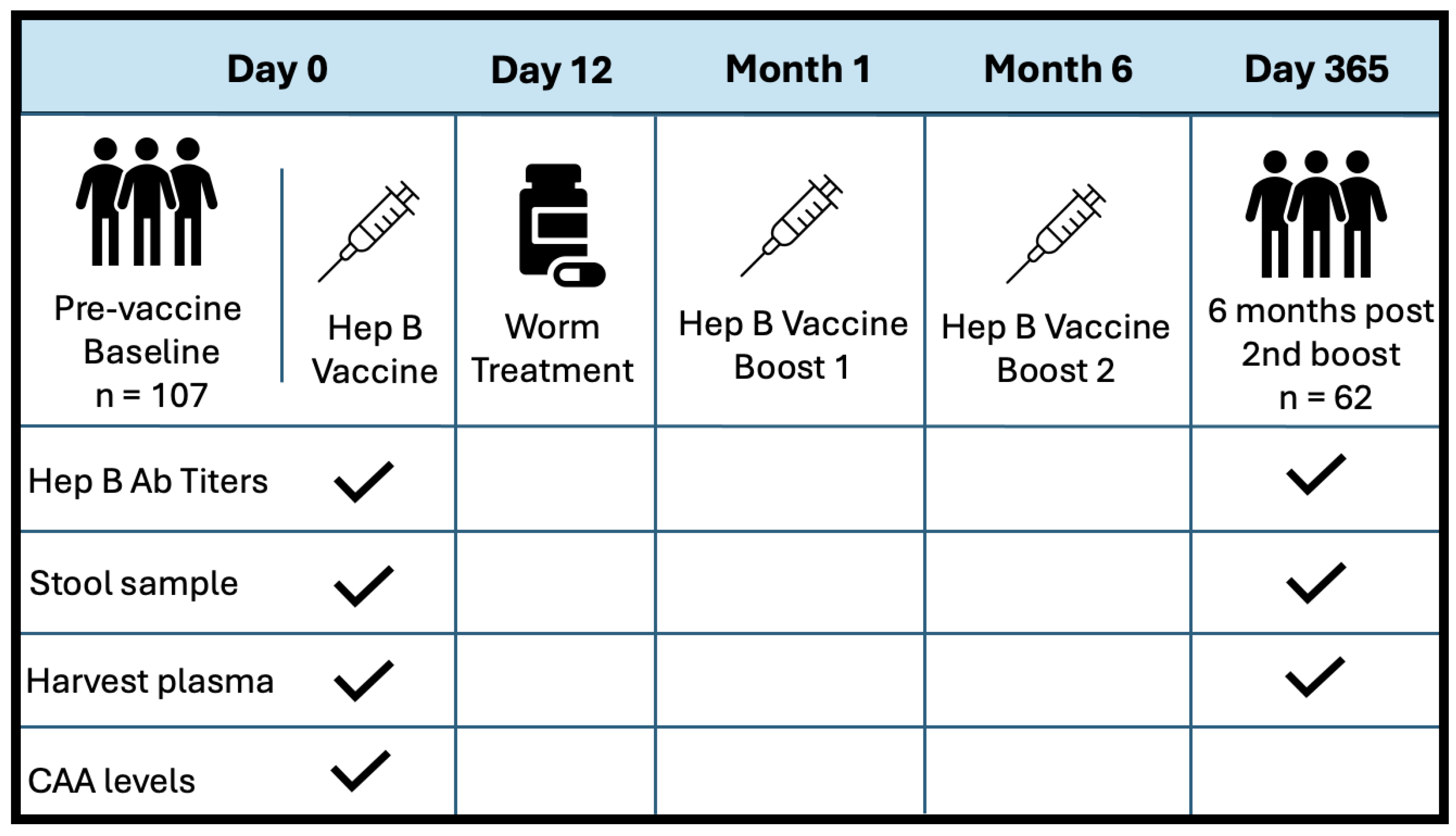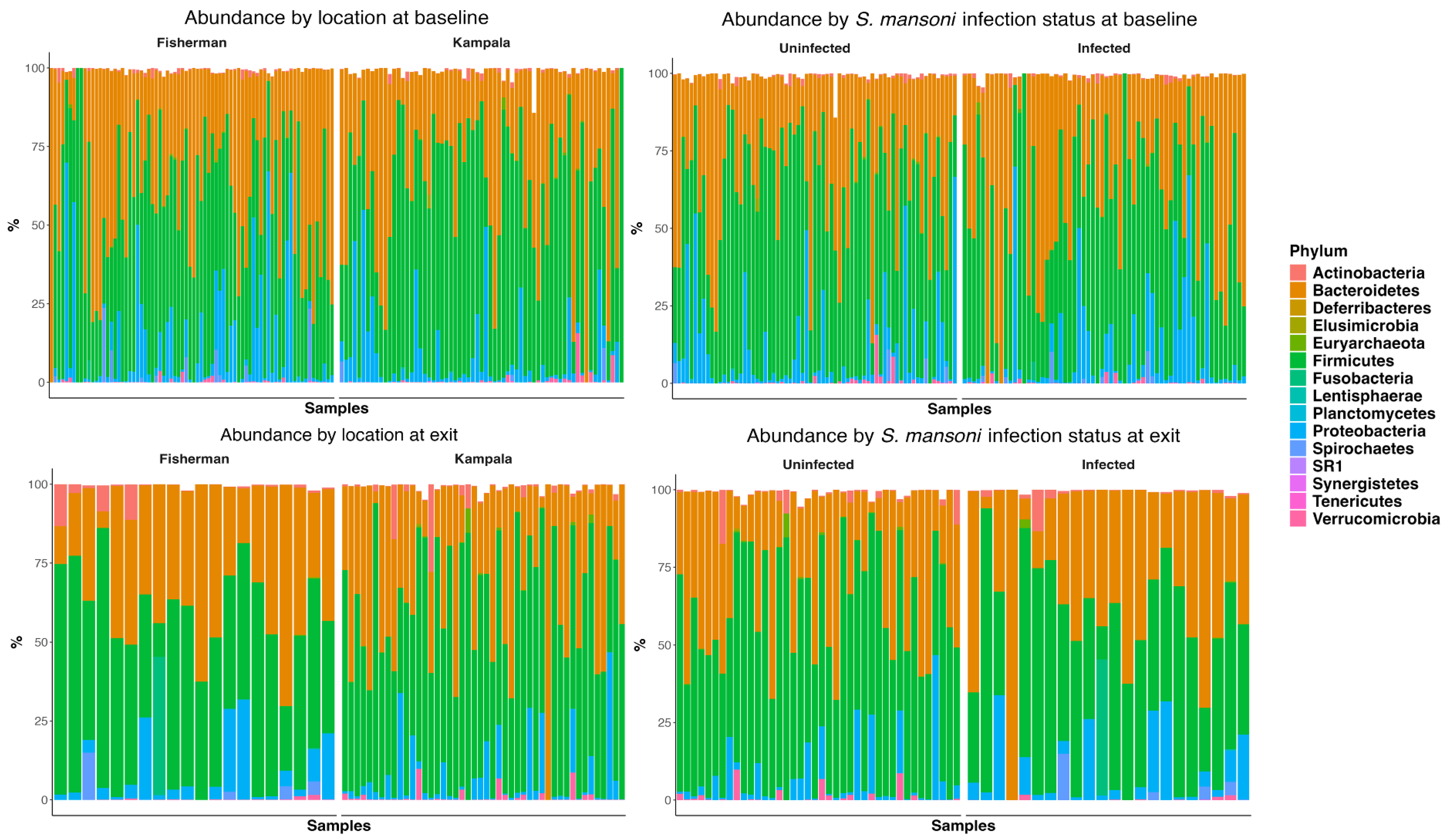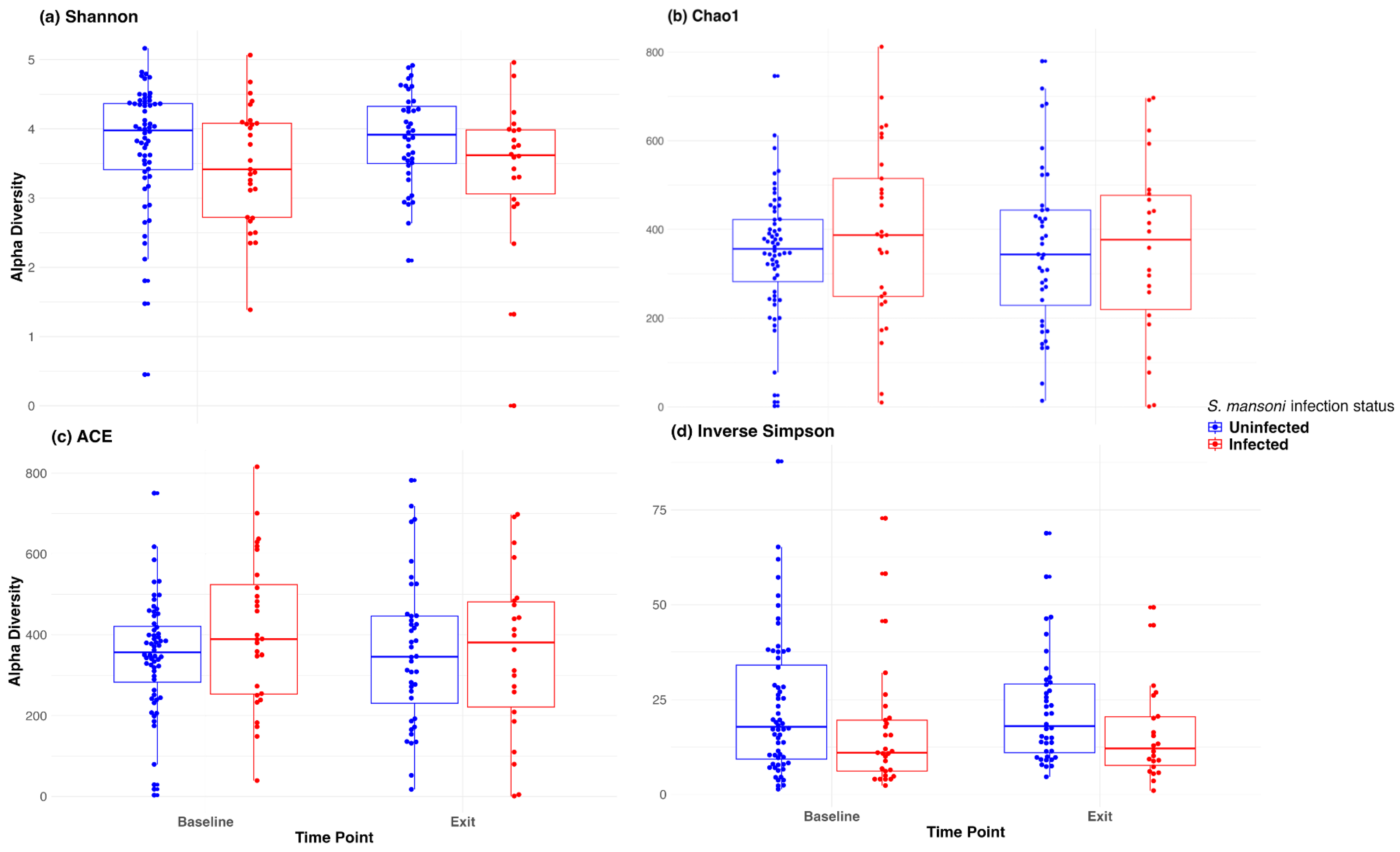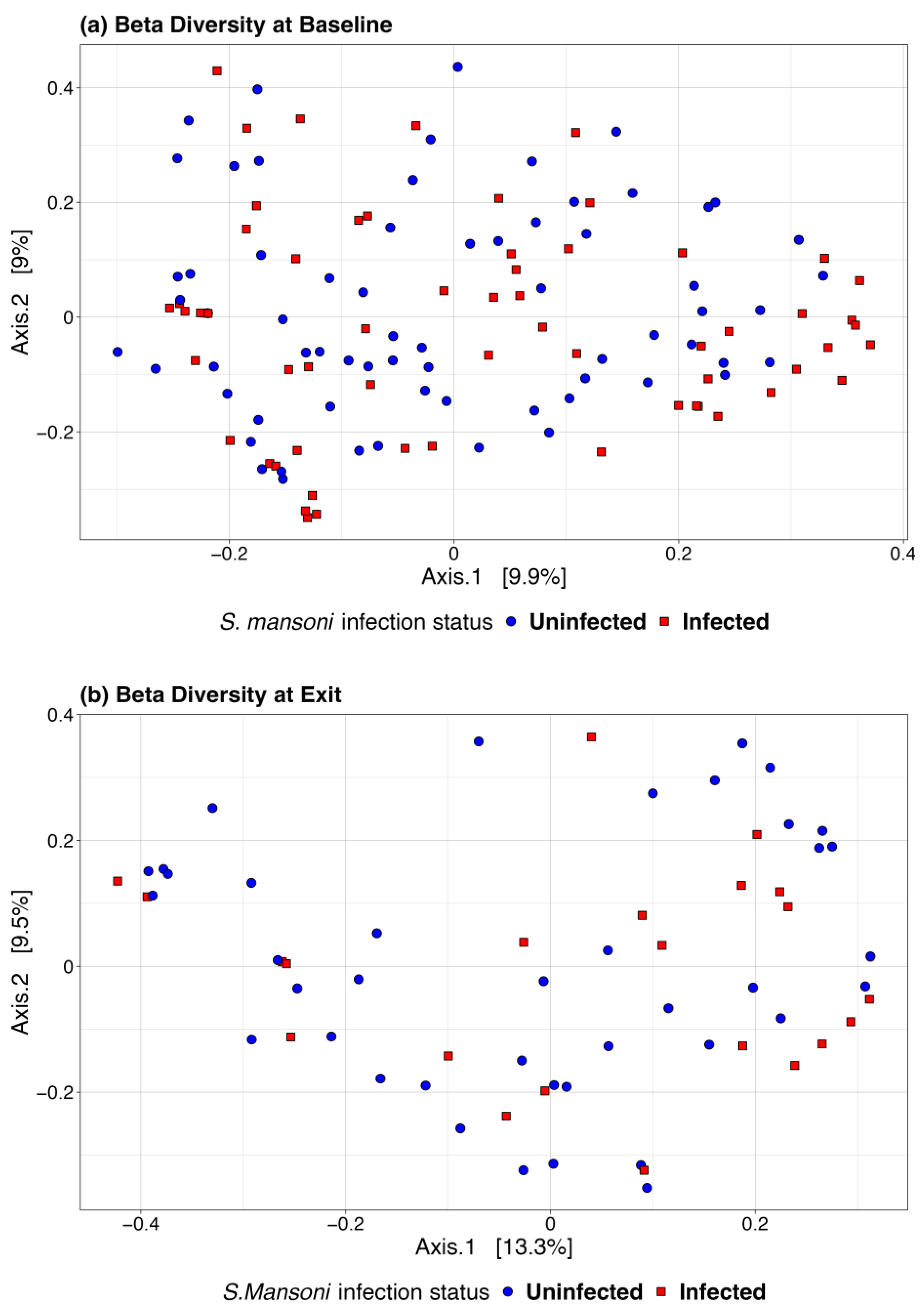Impact of Schistosoma mansoni Infection on the Gut Microbiome and Hepatitis B Vaccine Immune Response in Fishing Communities of Lake Victoria, Uganda
Abstract
1. Introduction
2. Materials and Methods
2.1. Study Design
2.2. Circulating Anodic Antigen (CAA) Assay
2.3. Hepatitis B Antibody Testing
2.4. Microbiome Analysis Using 16S rRNA Sequencing
2.5. Statistical Analysis
2.6. Ethical Approval
3. Results
3.1. Microbiome Composition Analysis
3.2. Regression Model
4. Discussion
5. Limitations
6. Conclusions
Supplementary Materials
Author Contributions
Funding
Institutional Review Board Statement
Informed Consent Statement
Data Availability Statement
Acknowledgments
Conflicts of Interest
References
- Jordan, A.; Carding, S.R.; Hall, L.J. The early-life gut microbiome and vaccine efficacy. Lancet Microbe 2022, 3, e787–e794. [Google Scholar]
- Vlasova, A.N.; Takanashi, S.; Miyazaki, A.; Rajashekara, G.; Saif, L.J. How the gut microbiome regulates host immune responses to viral vaccines. Curr. Opin. Virol. 2019, 37, 16–25. [Google Scholar] [PubMed]
- Zimmermann, P.; Curtis, N. The influence of the intestinal microbiome on vaccine responses. Vaccine 2018, 36, 4433–4439. [Google Scholar]
- Amenyogbe, N.; Kollmann, T.R.; Ben-Othman, R. Early-life host–microbiome interphase: The key frontier for immune development. Front. Pediatr. 2017, 5, 111. [Google Scholar]
- Dogra, S.K.; Chung, C.K.; Wang, D.; Sakwinska, O.; Colombo Mottaz, S.; Sprenger, N. Nurturing the early life gut microbiome and immune maturation for long term health. Microorganisms 2021, 9, 2110. [Google Scholar] [CrossRef] [PubMed]
- Zheng, D.; Liwinski, T.; Elinav, E. Interaction between microbiota and immunity in health and disease. Cell Res. 2020, 30, 492–506. [Google Scholar]
- Ciabattini, A.; Olivieri, R.; Lazzeri, E.; Medaglini, D. Role of the microbiota in the modulation of vaccine immune responses. Front. Microbiol. 2019, 10, 1305. [Google Scholar]
- Lynn, D.J.; Pulendran, B. The potential of the microbiota to influence vaccine responses. J. Leukoc. Biol. 2018, 103, 225–231. [Google Scholar]
- Brodin, P.; Davis, M.M. Human immune system variation. Nat. Rev. Immunol. 2017, 17, 21–29. [Google Scholar]
- Ponziani, F.R.; Coppola, G.; Rio, P.; Caldarelli, M.; Borriello, R.; Gambassi, G.; Gasbarrini, A.; Cianci, R. Factors influencing microbiota in modulating vaccine immune response: A long way to go. Vaccines 2023, 11, 1609. [Google Scholar] [CrossRef]
- Shen-Orr, S.S.; Furman, D. Variability in the immune system: Of vaccine responses and immune states. Curr. Opin. Immunol. 2013, 25, 542–547. [Google Scholar] [PubMed]
- Valdez, Y.; Brown, E.M.; Finlay, B.B. Influence of the microbiota on vaccine effectiveness. Trends Immunol. 2014, 35, 526–537. [Google Scholar]
- Huda, M.N.; Lewis, Z.; Kalanetra, K.M.; Rashid, M.; Ahmad, S.M.; Raqib, R.; Qadri, F.; Underwood, M.A.; Mills, D.A.; Stephensen, C.B. Stool microbiota and vaccine responses of infants. Pediatrics 2014, 134, e362–e372. [Google Scholar]
- Abavisani, M.; Ebadpour, N.; Khoshrou, A.; Sahebkar, A. Boosting vaccine effectiveness: The groundbreaking role of probiotics. J. Agric. Food Res. 2024, 16, 101189. [Google Scholar]
- Vlasova, A.N.; Kandasamy, S.; Chattha, K.S.; Rajashekara, G.; Saif, L.J. Comparison of probiotic lactobacilli and bifidobacteria effects, immune responses and rotavirus vaccines and infection in different host species. Vet. Immunol. Immunopathol. 2016, 172, 72–84. [Google Scholar] [PubMed]
- Licciardi, P.V.; Tang, M.L. Vaccine adjuvant properties of probiotic bacteria. Discov. Med. 2011, 12, 525–533. [Google Scholar]
- Vitetta, L.; Saltzman, E.T.; Thomsen, M.; Nikov, T.; Hall, S. Adjuvant probiotics and the intestinal microbiome: Enhancing vaccines and immunotherapy outcomes. Vaccines 2017, 5, 50. [Google Scholar] [CrossRef] [PubMed]
- Atarashi, K.; Tanoue, T.; Shima, T.; Imaoka, A.; Kuwahara, T.; Momose, Y.; Cheng, G.; Yamasaki, S.; Saito, T.; Ohba, Y. Induction of colonic regulatory T cells by indigenous Clostridium species. Science 2011, 331, 337–341. [Google Scholar]
- Oh, J.Z.; Ravindran, R.; Chassaing, B.; Carvalho, F.A.; Maddur, M.S.; Bower, M.; Hakimpour, P.; Gill, K.P.; Nakaya, H.I.; Yarovinsky, F. TLR5-mediated sensing of gut microbiota is necessary for antibody responses to seasonal influenza vaccination. Immunity 2014, 41, 478–492. [Google Scholar]
- Zimmermann, P.; Curtis, N. The influence of probiotics on vaccine responses–a systematic review. Vaccine 2018, 36, 207–213. [Google Scholar]
- Liu, Y.; Zhou, J.; Yang, Y.; Chen, X.; Chen, L.; Wu, Y. Intestinal Microbiota and Its Effect on Vaccine-Induced Immune Amplification and Tolerance. Vaccines 2024, 12, 868. [Google Scholar] [CrossRef] [PubMed]
- Arioz Tunc, H.; Childs, C.E.; Swann, J.R.; Calder, P.C. The effect of oral probiotics on response to vaccination in older adults: A systematic review of randomised controlled trials. Age Ageing 2024, 53 (Suppl. S2), ii70–ii79. [Google Scholar] [PubMed]
- Exum, N.G.; Kibira, S.P.; Ssenyonga, R.; Nobili, J.; Shannon, A.K.; Ssempebwa, J.C.; Tukahebwa, E.M.; Radloff, S.; Schwab, K.J.; Makumbi, F.E. The prevalence of schistosomiasis in Uganda: A nationally representative population estimate to inform control programs and water and sanitation interventions. PLoS Neglected Trop. Dis. 2019, 13, e0007617. [Google Scholar]
- Loewenberg, S. Uganda’s struggle with schistosomiasis. Lancet 2014, 383, 1707–1708. [Google Scholar]
- Muir, R.; Metcalf, T.; Fourati, S.; Bartsch, Y.; Kyosiimire-Lugemwa, J.; Canderan, G.; Alter, G.; Muyanja, E.; Okech, B.; Namatovu, T. Schistosoma mansoni infection alters the host pre-vaccination environment resulting in blunted Hepatitis B vaccination immune responses. PLoS Neglected Trop. Dis. 2023, 17, e0011089. [Google Scholar]
- Sanya, R.E.; Muhangi, L.; Nampijja, M.; Nannozi, V.; Nakawungu, P.K.; Abayo, E.; Webb, E.L.; Elliott, A.M. Schistosoma mansoni and HIV infection in a Ugandan population with high HIV and helminth prevalence. Trop. Med. Int. Health 2015, 20, 1201–1208. [Google Scholar] [CrossRef] [PubMed] [PubMed Central]
- Ssetaala, A.; Nakiyingi-Miiro, J.; Asiki, G.; Kyakuwa, N.; Mpendo, J.; Van Dam, G.J.; Corstjens, P.L.; Pala, P.; Nielsen, L.; Bont, J.; et al. Schistosoma mansoni and HIV acquisition in fishing communities of Lake Victoria, Uganda: A nested case-control study. Trop. Med. Int. Health 2015, 20, 1190–1195. [Google Scholar] [CrossRef] [PubMed] [PubMed Central]
- Bullington, B.W.; Klemperer, K.; Mages, K.; Chalem, A.; Mazigo, H.D.; Changalucha, J.; Kapiga, S.; Wright, P.F.; Yazdanbakhsh, M.M.; Downs, J.A. Effects of schistosomes on host anti-viral immune response and the acquisition, virulence, and prevention of viral infections: A systematic review. PLoS Pathog. 2021, 17, e1009555. [Google Scholar]
- Holzscheiter, M.; Layland, L.E.; Loffredo-Verde, E.; Mair, K.; Vogelmann, R.; Langer, R.; Wagner, H.; Prazeres da Costa, C. Lack of host gut microbiota alters immune responses and intestinal granuloma formation during schistosomiasis. Clin. Exp. Immunol. 2014, 175, 246–257. [Google Scholar]
- Stark, K.A.; Rinaldi, G.; Cortés, A.; Costain, A.; MacDonald, A.S.; Cantacessi, C. The role of the host gut microbiome in the pathophysiology of schistosomiasis. Parasite Immunol. 2023, 45, e12970. [Google Scholar]
- Kitandwe, P.K.; Muyanja, E.; Nakaweesa, T.; Nanvubya, A.; Ssetaala, A.; Mpendo, J.; Okech, B.; Bagaya, B.S.; Kiwanuka, N.; Price, M.A. Hepatitis B prevalence and incidence in the fishing communities of Lake Victoria, Uganda: A retrospective cohort study. BMC Public Health 2021, 21, 394. [Google Scholar] [CrossRef] [PubMed]
- Shepard, C.W.; Simard, E.P.; Finelli, L.; Fiore, A.E.; Bell, B.P. Hepatitis B virus infection: Epidemiology and vaccination. Epidemiol. Rev. 2006, 28, 112–125. [Google Scholar] [CrossRef] [PubMed]
- Opendi, S. World Hepatitis Day 2018: Press Statement on the Progress of Implementation of Hepatitis B Vaccination Program in Uganda; Government Uganda: Kampala, Uganda, 2018. [Google Scholar]
- Ocan, M.; Acheng, F.; Otike, C.; Beinomugisha, J.; Katete, D.; Obua, C. Antibody levels and protection after Hepatitis B vaccine in adult vaccinated healthcare workers in northern Uganda. PLoS ONE 2022, 17, e0262126. [Google Scholar]
- Walayat, S.; Ahmed, Z.; Martin, D.; Puli, S.; Cashman, M.; Dhillon, S. Recent advances in vaccination of non-responders to standard dose hepatitis B virus vaccine. World J. Hepatol. 2015, 7, 2503. [Google Scholar] [PubMed]
- Joo, E.-J.; Cheong, H.S.; Kwon, M.-J.; Sohn, W.; Kim, H.-N.; Cho, Y.K. Relationship between gut microbiome diversity and hepatitis B viral load in patients with chronic hepatitis B. Gut Pathog. 2021, 13, 65. [Google Scholar] [PubMed]
- Shen, Y.; Wu, S.-D.; Chen, Y.; Li, X.-Y.; Zhu, Q.; Nakayama, K.; Zhang, W.-Q.; Weng, C.-Z.; Zhang, J.; Wang, H.-K. Alterations in gut microbiome and metabolomics in chronic hepatitis B infection-associated liver disease and their impact on peripheral immune response. Gut Microbes 2023, 15, 2155018. [Google Scholar] [PubMed]
- Mbonye, M.; Seeley, J.; Nalugya, R.; Kiwanuka, T.; Bagiire, D.; Mugyenyi, M.; Namale, G.; Mayanja, Y.; Kamali, A. Test and treat: The early experiences in a clinic serving women at high risk of HIV infection in Kampala. AIDS Care 2016, 28 (Suppl. S3), 33–38. [Google Scholar]
- Fadrosh, D.W.; Ma, B.; Gajer, P.; Sengamalay, N.; Ott, S.; Brotman, R.M.; Ravel, J. An improved dual-indexing approach for multiplexed 16S rRNA gene sequencing on the Illumina MiSeq platform. Microbiome 2014, 2, 6. [Google Scholar]
- Galiwango, R.M.; Bagaya, B.; Mpendo, J.; Joag, V.; Okech, B.; Nanvubya, A.; Ssetaala, A.; Muwanga, M.; Kaul, R. Protocol for a randomized clinical trial exploring the effect of antimicrobial agents on the penile microbiota, immunology and HIV susceptibility of Ugandan men. Trials 2019, 20, 443. [Google Scholar]
- Proctor, L.M. The national institutes of health human microbiome project. Semin. Fetal Neonatal Med. 2016, 21, 368–372. [Google Scholar] [CrossRef]
- Turnbaugh, P.J.; Ley, R.E.; Hamady, M.; Fraser-Liggett, C.M.; Knight, R.; Gordon, J.I. The human microbiome project. Nature 2007, 449, 804–810. [Google Scholar] [CrossRef] [PubMed]
- DeSantis, T.Z.; Hugenholtz, P.; Larsen, N.; Rojas, M.; Brodie, E.L.; Keller, K.; Huber, T.; Dalevi, D.; Hu, P.; Andersen, G.L. Greengenes, a chimera-checked 16S rRNA gene database and workbench compatible with ARB. Appl. Environ. Microbiol. 2006, 72, 5069–5072. [Google Scholar] [CrossRef] [PubMed]
- Can, M. Annotation of bacteria by Greengenes classifier using 16S rRNA gene hyper variable regions. Southeast Eur. J. Soft Comput. 2018, 7, 35–45. [Google Scholar] [CrossRef]
- Zhou, Y.; Liu, Y.X.; Li, X. USEARCH 12: Open-source software for sequencing analysis in bioinformatics and microbiome. iMeta 2024, 3, e236. [Google Scholar] [CrossRef]
- Viana, S.D.R. Optmizing 16S Sequencing Analysis Pipelines. Master’s Thesis, Universidade de Lisboa, Lisbon, Portugal, 2016. [Google Scholar]
- Liu, C.M.; Aziz, M.; Kachur, S.; Hsueh, P.-R.; Huang, Y.-T.; Keim, P.; Price, L.B. BactQuant: An enhanced broad-coverage bacterial quantitative real-time PCR assay. BMC Microbiol. 2012, 12, 56. [Google Scholar] [CrossRef] [PubMed]
- Seong, H.; Yoon, J.G.; Nham, E.; Choi, Y.J.; Noh, J.Y.; Cheong, H.J.; Kim, W.J.; Kim, E.H.; Kim, C.; Han, Y.-H. The gut microbiota modifies antibody durability and booster responses after SARS-CoV-2 vaccination. J. Transl. Med. 2024, 22, 827. [Google Scholar] [CrossRef]
- Yuki, Y.; Nojima, M.; Hosono, O.; Tanaka, H.; Kimura, Y.; Satoh, T.; Imoto, S.; Uematsu, S.; Kurokawa, S.; Kashima, K. Oral MucoRice-CTB vaccine for safety and microbiota-dependent immunogenicity in humans: A phase 1 randomised trial. Lancet Microbe 2021, 2, e429–e440. [Google Scholar] [CrossRef]
- Chac, D.; Bhuiyan, T.R.; Saha, A.; Alam, M.M.; Salma, U.; Jahan, N.; Chowdhury, F.; Khan, A.I.; Ryan, E.T.; LaRocque, R. Gut microbiota and development of Vibrio cholerae-specific long-term memory B cells in adults after whole-cell killed oral cholera vaccine. Infect. Immun. 2021, 89, e0021721. [Google Scholar] [CrossRef]
- Lloyd-Price, J.; Abu-Ali, G.; Huttenhower, C. The healthy human microbiome. Genome Med. 2016, 8, 51. [Google Scholar] [CrossRef]
- Yatsunenko, T.; Rey, F.E.; Manary, M.J.; Trehan, I.; Dominguez-Bello, M.G.; Contreras, M.; Magris, M.; Hidalgo, G.; Baldassano, R.N.; Anokhin, A.P. Human gut microbiome viewed across age and geography. Nature 2012, 486, 222–227. [Google Scholar] [CrossRef]
- Labeaud, A.D.; Malhotra, I.; King, M.J.; King, C.L.; King, C.H. Do antenatal parasite infections devalue childhood vaccination? PLoS Neglected Trop. Dis. 2009, 3, e442. [Google Scholar] [CrossRef] [PubMed] [PubMed Central]
- Schmiedel, Y.; Mombo-Ngoma, G.; Labuda, L.A.; Janse, J.J.; de Gier, B.; Adegnika, A.A.; Issifou, S.; Kremsner, P.G.; Smits, H.H.; Yazdanbakhsh, M. CD4+CD25hiFOXP3+ Regulatory T Cells and Cytokine Responses in Human Schistosomiasis before and after Treatment with Praziquantel. PLoS Neglected Trop. Dis. 2015, 9, e0003995. [Google Scholar] [CrossRef] [PubMed] [PubMed Central]
- Bourke, C.D.; Nausch, N.; Rujeni, N.; Appleby, L.J.; Mitchell, K.M.; Midzi, N.; Mduluza, T.; Mutapi, F. Integrated analysis of innate, Th1, Th2, Th17, and regulatory cytokines identifies changes in immune polarisation following treatment of human schistosomiasis. J. Infect. Dis. 2013, 208, 159–169. [Google Scholar] [CrossRef] [PubMed] [PubMed Central]
- Tweyongyere, R.; Nassanga, B.R.; Muhwezi, A.; Odongo, M.; Lule, S.A.; Nsubuga, R.N.; Webb, E.L.; Cose, S.C.; Elliott, A.M. Effect of Schistosoma mansoni infection and its treatment on antibody responses to measles catch-up immunisation in pre-school children: A randomised trial. PLoS Neglected Trop. Dis. 2019, 13, e0007157. [Google Scholar] [CrossRef] [PubMed] [PubMed Central]
- Doenhoff, M.J.; Kusel, J.R.; Coles, G.C.; Cioli, D. Resistance of Schistosoma mansoni to praziquantel: Is there a problem? Trans. R. Soc. Trop. Med. Hyg. 2002, 96, 465–469. [Google Scholar] [CrossRef] [PubMed]
- Picquet, M.; Vercruysse, J.; Shaw, D.J.; Diop, M.; Ly, A. Efficacy of praziquantel against Schistosoma mansoni in northern Senegal. Trans. R. Soc. Trop. Med. Hyg. 1998, 92, 90–93. [Google Scholar]
- Fallon, P.G.; Doenhoff, M.J. Drug-resistant schistosomiasis: Resistance to praziquantel and oxamniquine induced in Schistosoma mansoni in mice is drug specific. Am. J. Trop. Med. Hyg. 1994, 51, 83–88. [Google Scholar]
- Nunan, F. Mobility and fisherfolk livelihoods on Lake Victoria: Implications for vulnerability and risk. Geoforum 2010, 41, 776–785. [Google Scholar]
- Ssetaala, A.; Ssempiira, J.; Nanyonjo, G.; Okech, B.; Chinyenze, K.; Bagaya, B.; Price, M.A.; Kiwanuka, N.; Degomme, O. Mobility for maternal health among women in hard-to-reach fishing communities on Lake Victoria, Uganda; a community-based cross-sectional survey. BMC Health Serv. Res. 2021, 21, 948. [Google Scholar]
- Kwena, Z.; Nakamanya, S.; Nanyonjo, G.; Okello, E.; Fast, P.; Ssetaala, A.; Oketch, B.; Price, M.; Kapiga, S.; Bukusi, E. Understanding mobility and sexual risk behaviour among women in fishing communities of Lake Victoria in East Africa: A qualitative study. BMC Public Health 2020, 20, 944. [Google Scholar]
- Tumwine, C.; Aggleton, P.; Bell, S. Accessing HIV treatment and care services in fishing communities around Lake Victoria in Uganda: Mobility and transport challenges. Afr. J. AIDS Res. 2019, 18, 205–214. [Google Scholar]
- Nakamanya, S.; Okello, E.S.; Kwena, Z.A.; Nanyonjo, G.; Bahemuka, U.M.; Kibengo, F.M.; Ssetaala, A.; Bukusi, E.A.; Kapiga, S.; Fast, P.E. Social networks, mobility, and HIV risk among women in the fishing communities of Lake Victoria. BMC Women’s Health 2022, 22, 555. [Google Scholar]
- Satterwhite, C.L.; Torrone, E.; Meites, E.; Dunne, E.F.; Mahajan, R.; Ocfemia, M.C.; Su, J.; Xu, F.; Weinstock, H. Sexually transmitted infections among US women and men: Prevalence and incidence estimates, 2008. Sex. Transm. Dis. 2013, 40, 187–193. [Google Scholar] [CrossRef] [PubMed]
- Asiki, G.; Mpendo, J.; Abaasa, A.; Agaba, C.; Nanvubya, A.; Nielsen, L.; Seeley, J.; Kaleebu, P.; Grosskurth, H.; Kamali, A. HIV and syphilis prevalence and associated risk factors among fishing communities of Lake Victoria, Uganda. Sex. Transm. Infect. 2011, 87, 511–515. [Google Scholar] [PubMed]
- Wandera, S.O.; Tumwesigye, N.M.; Walakira, E.J.; Kisaakye, P.; Wagman, J. Alcohol use, intimate partner violence, and HIV sexual risk behavior among young people in fishing communities of Lake Victoria, Uganda. BMC Public Health 2021, 21, 544. [Google Scholar]
- Ssetaala, A.; Welsh, S.; Nakaweesa, T.; Wambuzi, M.; Nanyonjo, G.; Nanvubya, A.; Mpendo, J.; Nalutaaya, A.; Ssempiira, J.; Nielsen, L. Healthcare use and sexually transmitted infections treatment-seeking: A mixed methods cross-sectional survey among hard-to-reach fishing communities of Lake Victoria, Uganda. Pan Afr. Med. J. 2024, 48, 134. [Google Scholar] [PubMed]
- Mayanja, Y.; Rida, W.; Kimani, J.; Ssetala, A.; Mpendo, J.; Nanvubya, A.; Mutua, G.; Anzala, O.; Price, M.A. Hepatitis B status and associated factors among participants screened for simulated HIV vaccine efficacy trials in Kenya and Uganda. PLoS ONE 2023, 18, e0288604. [Google Scholar]
- Deng, Y.; Umbach, A.K.; Neufeld, J.D. Nonparametric richness estimators Chao1 and ACE must not be used with amplicon sequence variant data. ISME J. 2024, 18, wrae106. [Google Scholar] [CrossRef]
- Hughes, J.B.; Hellmann, J.J.; Ricketts, T.H.; Bohannan, B.J. Counting the uncountable: Statistical approaches to estimating microbial diversity. Appl. Environ. Microbiol. 2001, 67, 4399–4406. [Google Scholar] [CrossRef] [PubMed] [PubMed Central]





| Baseline Characteristic | Full Sample | Kampala | Fisherman | |
|---|---|---|---|---|
| n (%) | n (%) | n (%) | p-Value 1 | |
| Age Category (years) | ||||
| 15–25 | 39 (36) | 24 (38) | 15 (34) | 0.261 |
| 26–35 | 51 (48) | 27 (43) | 24 (55) | |
| 36+ | 16 (15) | 12 (19) | 4 (9) | |
| No age given | 1 (1) | 0 | 1 (2) | |
| Mean age (SD) | 28.1 (5.9) | 28.0 (6.3) | 28.2 (5.3) | |
| Gender | <0.001 | |||
| Female | 75 (70) | 63 (100) | 12 (27) | |
| Male | 31 (29) | 0 | 31 (71) | |
| Not given | 1(1) | 0 | 1 (2) | |
| S. mansoni Infection | <0.001 | |||
| Yes | 42 (39) | 8 (13) | 34 (77) | |
| No | 65 (61) | 55 (87) | 10 (23) | |
| Total | 107 | 63(59) | 44 (41) |
| Effect | Estimate | SE | 95% CI | p | |
|---|---|---|---|---|---|
| LL | UL | ||||
| Intercept | 3.773 | 0.629 | 2.514 | 5.031 | 0 |
| Chao1 | 0.001 | 8 × 10−4 | −0.000 | 0.003 | 0.076 |
| Infected (yes) | 1.241 | 0.538 | 0.164 | 2.317 | 0.025 |
| Age (years) | −0.057 | 0.017 | −0.091 | −0.023 | 0.001 |
| Sex (female) | 0.389 | 0.313 | −0.237 | 1.015 | 0.218 |
| Chao1 × Infection status | −0.002 | 0.001 | −0.004 | 0.0004 | 0.113 |
| Multiple R2 | 0.25 | ||||
| Adjusted R2 | 0.19 | ||||
Disclaimer/Publisher’s Note: The statements, opinions and data contained in all publications are solely those of the individual author(s) and contributor(s) and not of MDPI and/or the editor(s). MDPI and/or the editor(s) disclaim responsibility for any injury to people or property resulting from any ideas, methods, instructions or products referred to in the content. |
© 2025 by the authors. Licensee MDPI, Basel, Switzerland. This article is an open access article distributed under the terms and conditions of the Creative Commons Attribution (CC BY) license (https://creativecommons.org/licenses/by/4.0/).
Share and Cite
Wang, Y.; Waters, A.K.; Basalirwa, G.; Ssetaala, A.; Mpendo, J.; Namuniina, A.; Keneema, E.; Kiiza, D.; Kyosiimire-Lugemwa, J.; Mayanja, Y.; et al. Impact of Schistosoma mansoni Infection on the Gut Microbiome and Hepatitis B Vaccine Immune Response in Fishing Communities of Lake Victoria, Uganda. Vaccines 2025, 13, 375. https://doi.org/10.3390/vaccines13040375
Wang Y, Waters AK, Basalirwa G, Ssetaala A, Mpendo J, Namuniina A, Keneema E, Kiiza D, Kyosiimire-Lugemwa J, Mayanja Y, et al. Impact of Schistosoma mansoni Infection on the Gut Microbiome and Hepatitis B Vaccine Immune Response in Fishing Communities of Lake Victoria, Uganda. Vaccines. 2025; 13(4):375. https://doi.org/10.3390/vaccines13040375
Chicago/Turabian StyleWang, Yan, Ariana K. Waters, Geofrey Basalirwa, Ali Ssetaala, Juliet Mpendo, Annemarie Namuniina, Emily Keneema, David Kiiza, Jacqueline Kyosiimire-Lugemwa, Yunia Mayanja, and et al. 2025. "Impact of Schistosoma mansoni Infection on the Gut Microbiome and Hepatitis B Vaccine Immune Response in Fishing Communities of Lake Victoria, Uganda" Vaccines 13, no. 4: 375. https://doi.org/10.3390/vaccines13040375
APA StyleWang, Y., Waters, A. K., Basalirwa, G., Ssetaala, A., Mpendo, J., Namuniina, A., Keneema, E., Kiiza, D., Kyosiimire-Lugemwa, J., Mayanja, Y., Okech, B., & Kiwuwa-Muyingo, S. (2025). Impact of Schistosoma mansoni Infection on the Gut Microbiome and Hepatitis B Vaccine Immune Response in Fishing Communities of Lake Victoria, Uganda. Vaccines, 13(4), 375. https://doi.org/10.3390/vaccines13040375





